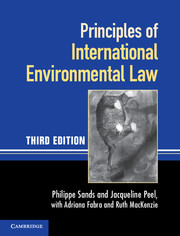Book contents
- Frontmatter
- Contents
- Foreword
- Preface and acknowledgments to the first edition
- Preface and acknowledgments to the second edition
- Preface and acknowledgments to the third edition
- Table of cases
- Table of treaties and other international instruments
- Abbreviations
- Part I The legal and institutional framework
- Part II Principles and rules establishing standards
- 6 General principles and rules
- 7 Atmospheric protection and climate change
- 8 Freshwater resources
- 9 Oceans, seas and marine living resources
- 10 Biological diversity
- 11 Hazardous substances and activities
- 12 Waste
- 13 The polar regions: Antarctica and the Arctic
- Part III Techniques for implementing international principles and rules
- Part IV Linkage of international environmental law and other areas of international law
- Index
- References
13 - The polar regions: Antarctica and the Arctic
from Part II - Principles and rules establishing standards
Published online by Cambridge University Press: 05 June 2012
- Frontmatter
- Contents
- Foreword
- Preface and acknowledgments to the first edition
- Preface and acknowledgments to the second edition
- Preface and acknowledgments to the third edition
- Table of cases
- Table of treaties and other international instruments
- Abbreviations
- Part I The legal and institutional framework
- Part II Principles and rules establishing standards
- 6 General principles and rules
- 7 Atmospheric protection and climate change
- 8 Freshwater resources
- 9 Oceans, seas and marine living resources
- 10 Biological diversity
- 11 Hazardous substances and activities
- 12 Waste
- 13 The polar regions: Antarctica and the Arctic
- Part III Techniques for implementing international principles and rules
- Part IV Linkage of international environmental law and other areas of international law
- Index
- References
Summary
INTRODUCTION
The Antarctic and the Arctic polar regions are subject to special regional rules of environmental protection. These rules reflect the unique physical conditions of these areas and the important role they play in maintaining regional and global environmental conditions. They also provide useful models for the development of international environmental law in other regions and globally. For the Antarctic, the environmental rules have developed in the context of complex legal issues arising from claims made by some states to sovereign rights over Antarctic territory, and the opposing view of most other states that the Antarctic is part of the global commons and not subject to the exclusive jurisdiction of any state. These differences have not prevented the adoption of innovative and potentially far-reaching rules for the protection of the Antarctic environment and its ecosystem. The Arctic region, on the other hand, is subject to the undisputed jurisdiction of certain states, and for the most part environmental protection in that area is based on national environment laws, although these may implement international environmental obligations. In 1991, Arctic states recognised the need for international co-operation to address threats to the Arctic environment and its ecosystem in the knowledge that it too plays an important role in maintaining the global environmental balance. In 1996, they established the Arctic Council, a high-level intergovernmental forum designed to provide a mechanism to address the common concerns and challenges faced by the Arctic governments and the peoples of the Arctic.
- Type
- Chapter
- Information
- Principles of International Environmental Law , pp. 577 - 598Publisher: Cambridge University PressPrint publication year: 2012



